Abstract
Economic and environmental factors call for increased resource productivity. Partial or full replacement of Portland cement by wastes and by-products, and natural aggregates by construction and demolition wastes, are two prominent routes of achieving circular economy in construction and related industries. Municipal solid waste incineration (MSWI) bottom ashes have been found to be suitable to be used as a supplementary cementitious material (SCM) after various treatments. This paper reports a brief literature review on optimum use of recycled aggregates in concrete and an experimental study using replacement of natural aggregate by demolished concrete having MSWI bottom ash as partial replacement of Portland cement, and compares its properties to that of completely natural aggregate concrete. Additional water was added as a compensation for the water absorption by the recycled aggregate during the first 30 min of water contact during concrete mixing. Also the fine fraction of crushed concrete (<250 µm) was removed to reduce the ill-effects of using recycled aggregate. The replacement of aggregates was limited to 23% by weight of natural aggregate. The results prove environmentally safe and comparable performance of concrete including recycled aggregate with bottom ash to that of natural aggregate concrete.
1. Introduction
Municipal solid waste incineration bottom ash is a residue generated as a result of incineration of waste that is not feasible or economical to be recycled. In Europe, around 17.6 million tonnes of MSWI bottom ashes are generated per year [1]. In Denmark, Netherlands, France and Germany, the utilisation is around 98%, 67%, 72% and 65% respectively. In Belgium, 15% of bottom ash generated is utilised in Belgium itself, mainly as aggregate in road construction, 35% is utilised outside Flanders, in the Netherlands and Germany, and the remaining 50% is landfilled after stabilisation [2,3,4]. However, it also has potential to be used in applications with higher value such as cement replacement. Obstacles for its use are presence of elemental aluminium, heavy metals, salts etc. and various treatments have been proven to be beneficial to make it suitable as a supplementary cementitious material [5,6,7].
The various aspects of effective utilisation of MSWI bottom ash for building materials were previously reviewed and published in [6]. Furthermore, an elaborate study was conducted to investigate utilisation of treated MSWI bottom ash as supplementary cementitious material. Pre-treatment methods to reduce ill-effects of MSWI bottom ash while used in concrete were devised and an optimised concrete mix containing processed MSWI ashes as 20% of the binder has been designed and its performance in terms of mechanical, durability and environmental properties was studied and is reported [8,9].
In order to establish circular economy, it is also important to utilise the concrete after its service life. The annual demand for aggregates is currently around 50 and 2.7 billion tonnes worldwide and in Europe respectively [10,11]. Around 450 million tonnes of C&D wastes are generated annually in EU and only 28% is recycled [12]. Use of recycled aggregates, reduces mining of natural aggregates and its related environmental problems, and is an answer partly to the shortage of aggregates. So, to prove that also concrete containing MSWI bottom ash as a supplementary cementitious material can find a second life as recycled aggregates at the end of its service life, concrete samples containing MSWI bottom ash as SCM were crushed and used as recycled aggregate. The mechanical and durability properties of the recycled aggregate concrete (RAC) were compared to that of natural aggregate concrete (NAC) and are reported in this paper.
2. Use of Recycled Concrete Aggregates as Replacement for Natural Aggregate
Literature encompasses various studies on use of recycled aggregates (RA) such as recycled concrete aggregate (RCA), recycled masonry aggregate (RMA) and mixed recycled aggregate (MRA) as replacement for natural aggregate (NA). However, RCA is focussed on here. The properties of concrete with recycled aggregate are affected by various factors. Factors relating to aggregates include water absorption of the aggregate, saturation level of aggregate at the time of mixing, grading and size of aggregate, constituents of the aggregate and source and crushing process of the aggregate [13,14]. Factors related to mix design and mixing of concrete include water-cement ratio, presence of mineral additions, use of chemical admixtures, curing age, recycled aggregate content and mixing procedure [15,16].
Water absorption of RCA is an indicator of its porosity and will influence the strength of the RAC. Aggregates with high water absorption partially absorb the mixing water and reduce workability and effective water-cement ratio, thereby affecting the fresh (mainly workability) and hardened concrete properties (mainly shrinkage) [17]. RCAs have high water absorption compared to NA [18], and the resulting decrease of free water in the mix up to a certain level could increase the strength, however, an excessive decrease in free water can deteriorate the strength of concrete due to lower hydration of cement particles and poor workability of the mix compared to conventional concrete.
The volume of voids among coarse aggregate particles is filled up by fine aggregates and cement paste, which affects the density, the amount of cement mortar and performance of concrete. Instead of replacing simply a part of natural aggregate by RA, the aggregates need to be graded according to size fraction. This gives rise to a better packing of the matrix resulting in better mechanical and durability properties [19]. A study showed that increasing the maximum size of aggregates increases the strength of resulting concrete. However, this limits the use of aggregates to large members and mass concreting [20].
The constituents of RA have high impact on its properties. RA sometimes contains wood, asphalt, plastic, glass etc. The bond between these materials and cement paste is very low and that affects the mechanical and durability properties of the resulting concrete [21]. Residual mortar content in RA, and its condition also has an important effect on its properties [22,23]. Higher content of residual mortar in aggregates increases porosity, water absorption, and may affect associated properties. Strength and other hardened concrete properties decrease. Residual mortar content also has an effect on the shape parameters. It gives more angular shape and rough texture to the recycled concrete aggregate, and this significantly affects particle packing. Increase in angularity leads to increase in void content, and thus leads to higher paste demand [24].
The type of aggregate in the original concrete is also found to have an effect. Concrete with RA originating from concrete with pebbles used as coarse aggregate was found to have higher compressive strength than that with crushed rock as aggregates [25].
Properties of parent concrete determine the properties of the recycled aggregate to a great extent. RA generated from high strength concrete has high crushing strength, low porosity, low water absorption etc. [26,27]. In a study damage sensitivity of aggregates to recycling processes was assessed [28]. Three levels of crushing processes were conducted. Level 1 included primary crushing with jaw crusher and impact crusher and then separation into fine and coarse fraction. Level 2 and Level 3 consisted of an additional mechanical grinding step. While double crushing of the source concrete (Level 1) considerably reduced the density of the cracks in the coarse aggregate by eliminating the particles with microdefects and irregular voids, processing up to Level 3 introduced negligible new cracks. Only a very minor amount of cracking could be detected in adhered mortar or at the interfacial transition zone. Consequently, the recycled concrete aggregates obtained at each stage of the recycling process did not show any loss of integrity. Beyond this, extending of the recycling process up to Level 3 efficiently increased the physical performance of the concrete aggregate by reducing the adhering mortar [28].
Water to cement ratio of concrete is a major parameter influencing strength and workability. Actual water-cement ratio should be fixed taking into consideration the water absorption of aggregates. Use of pre-saturated aggregates affects the structure of the ITZ, which can be improved by use of mineral additions. Partially replacing fine aggregates by mineral additions was also found to improve the strength of RAC. Addition of superplasticizer can compensate for loss of workability and also facilitates reduction of water-cement ratio to improve the strength. Increase in content of RA usually decreases the strength of concrete depending on its quality. General agreement is that replacement of less than 30% does not alter the strength considerably [29].
3. Strategies to Improve Properties of Recycled Aggregate Concrete
Many problems associated with recycled aggregates are caused by cracked and adhered mortar on the surface of old aggregates. It is the presence of this mortar that leads to the increase in water absorption of the RCA and hence an increased water demand for the concrete made with RCA to maintain the workability. It leads to reduced strength and durability of the recycled aggregates and of the resulting concrete made with recycled aggregate. There are various options to reduce the ill-effects. These methods can be broadly classified into removal of the cement paste around the aggregates, strengthening the mortar around aggregate, and others related to mix design and mixing of concrete [30].
Removal of mortar can be done by mechanical grinding and sieving, acid treatment [13,31,32,33], heat treatment [30,33] or microwaving. Treatment of RCA in a Los Angeles abrasion machine for 300 revolutions with 12 charges and then sieving on 4.75 mm sieve decreased water absorption of aggregates by 32.3% [33]. Heating concrete to around 300 °C makes the mortar brittle and easier to remove by mechanical treatment [30]. Heating to high temperature and then suddenly quenching in water decreases the amount of mortar adhered to the aggregate and allows it to be removed easily by sieving or mechanical grinding [33,34]. Microwave heating makes concrete brittle which results in lower fracture energy. This makes it easier for the mortar fraction to be removed by mechanical grinding [35].
Strengthening of mortar can be done by carbonation, calcite deposition, mixing with pozzolan, cement slurry or polymer emulsion. Carbonation of Ca(OH)2 which produces calcium carbonate leads to reduction in porosity and thus improvement in quality of recycled aggregate. However, carbonation for long time at high concentration of CO2 leads to carbonation of C-S-H which increases the porosity of cement paste. Therefore, the carbonation treatment should be conducted at optimum CO2 concentration [36,37,38]. Immersion of RAs in lime water before carbonation can introduce more carbonatable calcium, and it was proven effective in improving tensile strength of the resulting concrete [39]. Immersion of recycled aggregates in lime water even without carbonation was shown to improve the properties [40]. Another recent innovation investigated using recycled fine powder slurry along with carbonation to treat RCAs and it was found beneficial in reducing the porosity [41]. Various strains of bacteria, especially of the bacillus group, precipitate calcium carbonate, and can be used to reduce porosity. Sporosarcina pasteurii (Bacillus pasteurii) [42] and Bacillus sphaericus [43] have been successfully studied for this purpose. Accelerated calcite precipitation by submerging RCA in water and dissolving CO2 in the water at high pressure was also studied [44]. Cement slurry [45], alkali activated binders [46] and various polymers have been tested to seal the pores and hence to reduce the water absorption of recycled aggregate. Polyvinyl alcohol (PVA) [47,48], silane or siloxane based polymers [49], sodium silicate [45], paraffin etc. were used effectively at optimum concentrations [30]. Spraying pozzolan slurry on recycled aggregate strengthens the cracks in the aggregate by reaction of the pozzolans with Ca(OH)2 in the waste concrete forming C-S-H [30].
A special mixing technique called two stage mixing technique (TSMA) was studied as well [50]. In TSMA first the recycled aggregates are mixed with cement paste which forms a coating on the surface of the aggregate and fills up cracks and voids, before the actual concrete mixing takes place [50]. This mixing procedure was also found to decrease the creep of resulting concrete [51]. Replacing part of the fine aggregate by mineral addition can be used as a strategy to increase the compressive strength of recycled aggregate concrete [14]. Addition of basalt fibre in the range of 0.1–0.5% was found to increase flexural and splitting tensile strength of RAC with marginal increase in compressive strength [32]. Equivalent mortar volume method is yet another method in which quantity and quality of cement paste and aggregate in the RA is accounted for, and both the coarse aggregate and fresh paste content of the mix are adjusted accordingly to achieve the same total mortar volume as a companion mix with the same specified properties but made entirely with coarse natural aggregates of similar properties to the coarse natural aggregate contained in RCA [52].
To avoid problems due to high water absorption of RA, the pre-saturation method or the water compensation method can be used. It was reported that not more than 90% of the total water absorption of the aggregate is absorbed during the first two hours after mixing, so not all of the measured water absorption of the aggregates needs to be added as compensation [24]. In the pre-saturation method, RAs are saturated prior to mixing, and in the water compensation method, additional water required for absorption by RAs is supplied during mixing of concrete. A study confirmed that concrete produced by the pre-saturation method had slightly inferior fresh and hardened properties compared to that produced by the water compensation method. The authors attributed this observation to the absence of nailing effect in pre-saturated aggregates, which is the penetration of cement paste in superficial pores in aggregates [53]. Various other studies reported higher strength for concrete made with dry RAs [54,55]. A microstructural study of RAC using microtomography reported that using RCA in dried state during mixing resulted in RCA absorbing water and releasing air bubbles inside the new concrete matrix as long as the concrete remained in the fresh state. Consequently, a macropore formed surrounding the RCA boundaries [56]. No systematic difference in compressive strength and carbonation resistance between concrete produced with dry and pre-saturated aggregates was observed [17].
These factors need to be incorporated into the quality control of concrete at various stages and they are summarised in Figure 1. Maximum utilisation of RCA can be made possible by preserving and improving its quality right from the demolition up to the mixing of concrete.
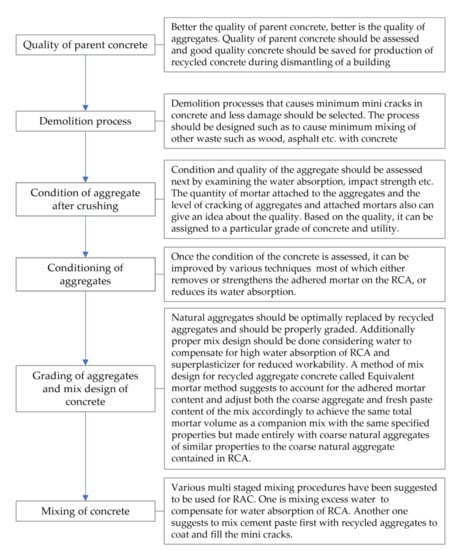
Figure 1.
Steps in the quality control of recycled aggregate concrete.
4. Aim of the Study
Although the improvement and application of RCA for use in new concrete has been extensively studied, as shown in the literature overview given above, the introduction of novel SCMs in the parent concrete could affect the properties of the RCA and new RAC. The aim of this study was to show that the application of MSWI bottom ashes as SCM in concrete, will not affect its suitability to have a second life as RCA after demolition of the concrete structure. Therefore, RCA were made from parent concrete containing MSWI bottom ashes as a fraction of the binder. New RAC made with those RCA was tested for its mechanical properties (strength, modulus of elasticity, creep, shrinkage), durability (air permeability, carbonation resistance), and possible negative effects on the environment by leaching of hazardous compounds.
5. Materials and Methods
The experimental study described in this paper is part of a broader study on effective utilisation of MSWI bottom ashes in cement and concrete. Previous parts of the study on pre-treatment of MSWI bottom ashes can be found in our paper by Joseph et al. [5] and results on mechanical, durability and environmental properties of the bottom ash concrete can be found in our article by Alderete et al. [8]. Presence of hazardous elements in the bottom ash is a primary concern for its use in building materials. The bottom ashes used in the study were first processed at the incineration site to extract valuable metals and to render them non-hazardous. The processing steps consisted of washing, sieving, crushing, magnetic and eddy current separation etc. Additionally the ashes were milled and remaining metals were separated. The fraction of bottom ash between size 2 and 6 mm was selected (called 2/6NB), and its chemical composition along with that of the cement CEM I 52.5R used in the parent concrete, determined by XRF, can be found in Table 1.

Table 1.
Chemical composition of cement and bottom ash used in the parent concrete and of the cement used in the RAC. Estimated relative error is ±10%.
Various mixes were cast as trial to obtain a mix design with optimum replacement of cement by milled 2/6NB targeting similar strength as that of a mix with only CEM I 52.5N as binder (the chemical composition of this cement is also shown in Table 1). In these trial mixes, the water to binder ratio ranged from 0.35 to 0.45 and the cement replacement rate ranged from 10 to 20%. Additionally, CEM I 52.5R was used in the mixes with bottom ashes, instead of CEM I 52.5N in the Portland cement mix, to compensate for delay in strength gain when cement replacement is done. Four of these trial mixes were selected to produce RCA and their composition is shown in Table 2. The compressive strength at 2, 7 and 28 days is shown in Figure 2.

Table 2.
Mix composition of parent concrete.
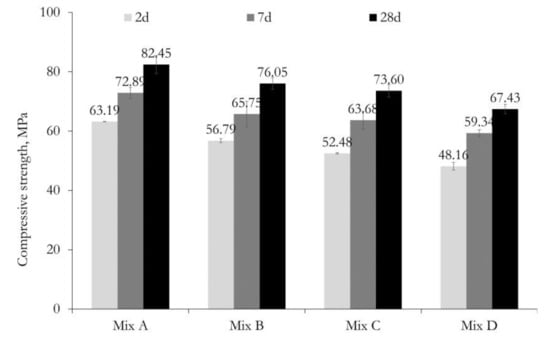
Figure 2.
Strength of parent concrete with processed MSWI bottom ash used as cement replacement.
The recycled aggregate was manufactured in the lab by crushing equal amounts of concrete remnants left from compressive strength testing of the four trial mixes A, B, C and D, in a laboratory jaw crusher, Matest A092, and sieving out the fraction with size <250 µm since the fines affect the quality of aggregate the most. The crusher had 16 jaws with minimum and maximum opening width of 5 and 15 mm respectively. A mix of crushed particles from the four concretes of the trial mixes was used as recycled aggregate. In this study, a comparison is made between a reference natural aggregate concrete NAC (identical to Mix 1 in Alderete et al. [8]) and a recycled aggregate concrete, designated as RAC. Taking the composition of the NAC and the obtained particle size distribution of the recycled aggregate as a starting point, the recycled concrete mix design has been made by replacing part of the natural aggregates 0/4 and 4/16 as such that the overall particle size distribution remained nearly the same. The particle size distributions of the aggregates used in the study are shown in Figure 3. Extra water was provided to the mix to account for the water absorption of the recycled aggregates during the first 30 min. Total water absorption of recycled aggregates was determined after soaking for 24 h. However, to assess the mentioned extra water for pre-wetting of the recycled aggregates, rather the water absorption during the first 30 min was considered, to avoid the negative effects of the pre-saturation method as discussed in Section 3. This corresponds to the approximate time required for mixing, placing and compacting of concrete. The mix compositions of NAC and RAC are given in Table 3. Overall, 23% (by weight) of the natural aggregates have been replaced, and 27% in reference to the 0/4 and 4/16 fractions of NAC. To obtain similar workability, the amount of superplasticiser was slightly increased, as suggested in the literature (see Section 2).
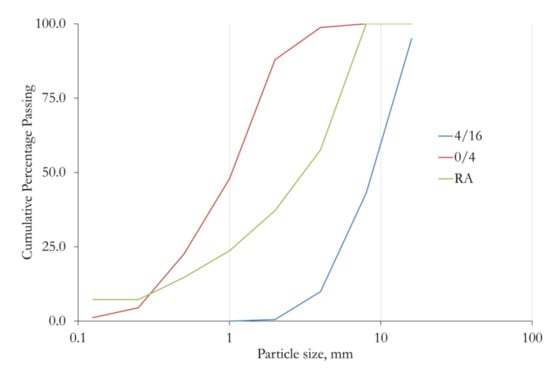
Figure 3.
Sieve analysis of aggregates used in NAC and RAC.

Table 3.
Composition of mixes used in the study (kg/m3).
The mixing procedure of NAC was as follows: first cement, fine and coarse aggregates were dry-mixed for a minute; then the water was added and the mixing continued for 2 more minutes, finally the plasticiser was added and mixed for 1 extra minute. For RAC, the following procedure was followed. First the aggregates with pre-wetting water were mixed for 1 min. Then binder (CEM I 52.5N) and remaining water was added, and the mixing continued for 2 more minutes; finally the plasticiser was added and mixed for 1 extra minute. All the concrete samples were demoulded 1 day after casting and cured in a climate room at a temperature of (20 ± 2) °C and a relative humidity (RH) higher than 95% until 28 or 90 days of age, after which they were cut and subjected to preconditioning and testing.
Compressive strength tests were carried out on cubes with side length of 150 mm according to the standard NBN B 15-220 (1990) [57]. Three samples per mix were tested at 2, 7, 28, and 91 days of age. The test for modulus of elasticity of concrete was performed on cylinders of 150 mm diameter and 300 mm height after 28 days of curing according to Belgian standard NBN B 15-203 (1990) [58]. During the test, the concrete sample was subjected to a pressure of one third of compressive strength for three times, and then up to failure. While loading, the load and the deformations of the measurement bases of the specimen were recorded electronically. The value of the modulus of elasticity was calculated as the slope of the ascending branch of the last loading-unloading cycle.
Creep testing was conducted according to standard NBN 15-228 [59] on four specimens of size 150 × 150 × 500 mm, two for total creep and two for basic creep. The specimens were cured until 28 days of age in a wet chamber. Then two specimens for basic creep were covered with aluminium tape, and mechanical deformeter points (type demec) were fixed on all four. The other two specimens were tested uncovered. Specimens were loaded in compression to 30% of their compressive strength; the load was maintained constant with pressure vessels and the strain was measured regularly during 14 days using the mechanical deformeter strain gauges of type demec with a base length of 200 mm. Shrinkage of concrete was measured according to standard NBN 15-216 [60] on four specimens of size 150 × 150 × 600 mm after a curing period of 24 h in a wet chamber. After curing, two specimens for basic shrinkage were covered with aluminium tape and mechanical deformeter points (type demec) were fixed on all four sides, both covered and uncovered, similar to the creep specimens. Then strain was measured regularly using the deformeter.
Samples for air permeability tests were cut from slabs of size 400 mm × 400 mm × 100 mm. Four cylinders of 150 mm diameter were cored out of the slab and the middle part was cut out. For carbonation, cylinders of diameter 80 mm and 48 mm height were cut out from cubes of side 100 mm. After the curing period, the samples for air permeability, capillary imbibition rate and carbonation were cut and immersed in water for 72 h, followed by drying at 50 °C till the mass change measured at 24 h intervals was less than 0.1%. The lateral surfaces of samples for carbonation were covered with epoxy resin. After drying the specimens were kept covered in polythene bags for 4 weeks for the moisture to redistribute in the specimens and to have a homogenous relative humidity in the pores.
Air permeability of the specimens was measured by Torrent permeability tester which is a non-destructive method to measure air permeability of concrete according to Swiss standard SIA 262/1:2013. After 4 weeks of homogenisation, the surface moisture content of the samples was measured using a screed moisture meter PCE PMI-4 that measures moisture content by calcium carbide method [61]. The air permeability apparatus was calibrated and the permeability was measured right away. Both pre-conditioning and measurement were carried out in a temperature and humidity-controlled room at 20 °C and 60% RH.
Specimens for carbonation testing were exposed to 1% CO2 in a conditioned chamber at 20 °C and a RH of 60%. Further, the carbonation depth was measured using phenolphthalein indicator. After different exposure times, specimens were taken out of the carbonation chamber and were split into two halves longitudinally and sprayed with 1% phenolphthalein solution. The carbonated region remains uncoloured and the uncarbonated region turns purple. Carbonation depth is measured at 8 points and its average is reported.
To further prove that the recycled concrete is safe for use, leaching was tested with the two-step shake test according to CMA/2/II/A9.4 [62] and the leachate was characterised using inductively coupled plasma mass spectrometry (ICP-MS). Both NAC and RAC concrete samples after 90 days were crushed first using a compression testing machine. Then the pieces were collected and crushed further with a hammer, and the fraction <4 mm was collected by sieving. In the first step, the sample is shaken at a liquid to solid ratio (L/S) of 2 L/kg for 6 h, and in the second step at 8 L/kg for 18 h. The cumulative L/S is 10 L/kg. The pH value and the composition of leachate was determined after leaching.
6. Results and Discussion
The 28 d compressive strength of concrete used for making recycled aggregate ranged from 67 to 82 MPa as shown in Figure 2. The minimum strength class of this parent concrete was C35/45. The average water absorption of the recycled aggregates at 24 h was obtained to be 6.1% (by weight). This order of magnitude is similar to what is typically reported for various kinds of recycled aggregates. The water absorption of natural aggregates typically lies below 1%, and that of recycled aggregate ranges between 2–20% depending on residual mortar content, cracking etc. [14]. The compressive strength of concrete in which natural aggregates were replaced for about 23% with RA is shown in Figure 4. The strength of RAC improved slightly with respect to NAC. The increase of strength at 28 days is around 16% and 9% at 90 days. Medium compressive strength concrete made with 25% of recycled coarse aggregates is reported to achieve the same mechanical properties as that of conventional concrete employing the same quantity of cement and the equal effective w/c ratio [16]. Here, the strength increase can be attributed to a combination of the following factors. The compressive strength of parent concrete used for production of the RCA ranged from 67 to 82 MPa, similar to or somewhat higher than that of NAC. Also, the fine part of RA which is less than 250 µm in size was removed by sieving. The grading of concrete particle sizes was optimised according to Fuller’s curve. Some water absorption by the recycled aggregates would still occur after 30 min, and hence the w/c effective of the RAC would still be lower than of NAC. This could also be an important reason for the higher strength. A major drawback of water absorption of the recycled aggregate is the reduced workability of concrete. Workability is also affected by the roughness and angular shape of recycled aggregates. This could lead to higher amount of compaction pores that could reduce the strength [63]. To mitigate this effect, additional water was added and also the workability was adjusted by using superplasticizer. The slump value of NAC and RAC was 188 and 175 mm respectively which belongs to the same slump class. The reduced effective water to binder ratio combined with similar slump will have resulted in better compressive strength of RAC.
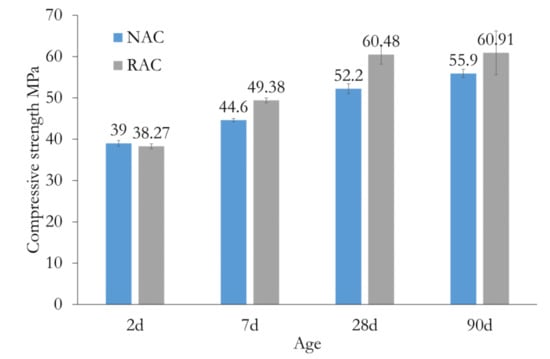
Figure 4.
Compressive strength of NAC and RAC at 2, 7, 28 and 90 days.
The modulus of elasticity value was significantly reduced by addition of recycled aggregate as shown in Figure 5. The reduction is around 17% which is similar as reported in literature. In literature, the modulus of elasticity is reported to be greatly reduced by the use of recycled aggregate; it can reach 45% of the modulus of elasticity of corresponding conventional concrete. This percentage reduction varies based on the percentage substitution. The 45% reduction was reported at 100% substitution, and a more moderate reduction of 15% was mentioned at 30% substitution [64].
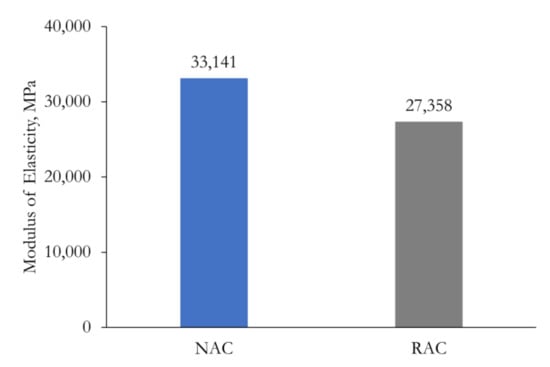
Figure 5.
Modulus of elasticity of NAC and RAC.
Total creep and basic creep of NAC and RAC are shown in Figure 6. It can be seen that both total and basic creep are higher for RAC. This could be attributed to the lower modulus of elasticity of the RAC. The difference in creep between RAC (with RCA) and NAC (reference) is more pronounced for the basic creep than for the total creep, meaning that the drying creep is more favourable. Total creep is highly affected by the permeability of concrete. Higher permeability results in faster loss of moisture, and this results in faster rise of strain. The value of air permeability of concrete NAC and RAC determined after 28 days of curing and pre-conditioning is shown in Figure 7. Both these values fall under the classification of moderate permeability (0.1–1 × 10−16). However, RAC has a lower value of air permeability compared to NAC, that results in a smaller difference between total creep and basic creep. The shrinkage values of both NAC and RAC are similar as can be seen in Figure 8. Shrinkage is highly affected by the binder, and similar shrinkage values could be attributed to the same binder and water to binder ratio used in both the mixes.
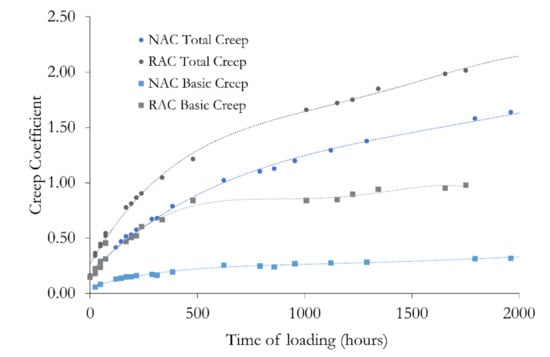
Figure 6.
Creep coefficient of NAC and RAC.

Figure 7.
Torrent air permeability values of NAC and RAC after 28 days of curing.
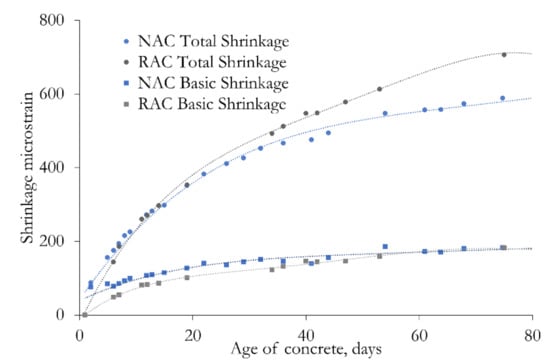
Figure 8.
Shrinkage strain of NAC and RAC.
The evolution of carbonation depth with time is shown in Figure 9a, and the carbonation coefficient in Figure 9b. It can be seen that recycled concrete has lower carbonation depth than conventional concrete, and the carbonation coefficient decreases by around 45%. Carbonation depth is mainly affected by air permeability and buffer capacity. Residual mortar content in the RCA which is not carbonated adds to the buffer capacity of RA concrete. Lower carbonation depth of RAC would be a combined effect of both higher buffer capacity and lower permeability. In addition to all the above aspects, the better quality of RAC can partly be attributed to use of recycled aggregate from known parent concrete with a strength class superior to that of the recycled aggregate concrete at moderate replacement levels.
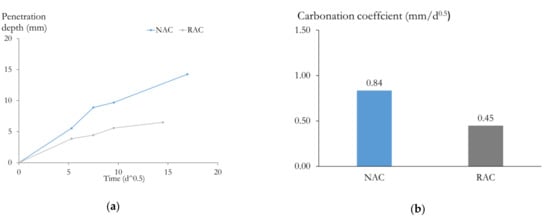
Figure 9.
(a) Evolution of carbonation depth with time and (b) carbonation coefficient of NAC and RAC.
The results of the two-step shake test conducted on crushed concrete, and the limits prescribed by VLAREMA (Decree of the Flemish Government establishing the Flemish regulation on the sustainable management of material cycles and waste) are shown in Table 4. VLAREMA limits indicate values for use of bottom ash in unshaped elements (e.g., road subbase). However, in this application, bottom ash is used in conjunction with concrete which dilutes the content of heavy metals, and also, the cement hydration process encapsulates much of the leachable elements which results in negligible amount of leached heavy metals. Only Cr was detected in concrete mixes, but the concentrations are well within the limits for use in even unbound applications and the leaching from the RAC is comparable to that from the NAC.

Table 4.
Heavy metal content and pH in eluates from leaching test and VLAREMA limits.
7. Conclusions and Perspectives
Optimum use of recycled aggregate in concrete can be made possible by taking various steps that can facilitate its preservation and use. The presence of adhered mortar on the surface of crushed concrete aggregate generally increases water absorption and degrades the quality of the recycled aggregate and consequently the fresh and hardened properties of concrete made from it. Recycled aggregate is generally considered inferior to natural aggregate in terms of technical properties. However, it can be used in moderate replacement ratios when proper measures are taken, reducing the environmental footprint of the final product without affecting the properties. Here, the experimental study showed that the replacement of 23% of NA by RCA from concrete with MSWI bottom ashes as SCM, produced concrete with comparable properties. The application of MSWI bottom ashes as SCM in the parent concrete, did not affect its suitability to have a second life as RCA. A decrease in properties was mostly noticed in terms of modulus of elasticity of the concrete. Compressive strength and pore structure improved due to presence of RA. Here, the recycled aggregate being from a parent concrete of superior strength class improved many of the properties of concrete. Further to that, removal of the fine fraction <250 µm in size and addition of water for compensation of water absorption will have added to improvement of workability and other properties. Proper guidelines regarding demolition techniques that preserve the quality of aggregates and techniques to improve the quality of each kind of recycled aggregate can thus increase its utilisation. Life cycle analysis should be conducted specific to the usage of the RA to better estimate the environmental benefits, since availability and impact of both natural aggregate and recycled aggregate varies locally. Production and treatment procedures could add to the environmental load for recycled aggregate [65,66]. The fines generated from sieving the aggregates could be used as a raw meal additive for manufacture of Portland cement production, which is already demonstrated in a previous study (up to ~15%) [67], thus leaving no waste behind ensuring circular economy.
Author Contributions
Formal analysis, A.M.J.; Funding acquisition, S.M. and N.D.B.; Investigation, A.M.J.; Methodology, A.M.J., S.M. and N.D.B.; Project administration, S.M.; Resources, S.M. and N.D.B.; Supervision, S.M. and N.D.B.; Writing—original draft, A.M.J.; Writing—review & editing, N.D.B. All authors have read and agreed to the published version of the manuscript.
Funding
This research is a part of ASHCEM project (grant number: IWT.150076) funded by Strategic Initiative Materials (SIM), Flanders and Flanders Agency for Innovation and Entrepreneurship(VLAIO).
Institutional Review Board Statement
Not applicable.
Informed Consent Statement
Not applicable.
Data Availability Statement
Data will be made available upon reasonable request.
Acknowledgments
The authors thank Natalia Alderete and other partners of ASHCEM project (grant number: IWT.150076), which in itself is a part of the bigger program MaRes aimed at creating and demonstrating an operational, flexible toolbox to recover metals and valorise the residual matrix into building materials funded by SIM (Strategic Initiative Materials in Flanders) and VLAIO (Flanders Innovation & Entrepreneurship). The financial support from the foundations for this study is gratefully appreciated.
Conflicts of Interest
The authors declare no conflict of interest.
References
- Blasenbauer, D.; Huber, F.; Lederer, J.; Quina, M.J.; Blanc-Biscarat, D.; Bogush, A.; Bontempi, E.; Blondeau, J.; Chimenos, J.M.; Dahlbo, H.; et al. Legal situation and current practice of waste incineration bottom ash utilisation in Europe. Waste Manag. 2020, 102, 868–883. [Google Scholar] [CrossRef] [PubMed]
- Leefmilieu, N.E.; OVAM; VITO. Monitoringsysteem Duurzaam Oppervlaktedelfstoffenbeleid; Department Leefmilieu, Natuur & Energie/OVAM/VITO: Brussel, Belgium, 2013.
- Kaza, S.; Yao, L.; Bhada-Tata, P.; Van Woerden, F. What a Waste 2.0; World Bank Publications: Washington, DC, USA, 2018; ISBN 9781464813290. [Google Scholar]
- Beylot, A.; Villeneuve, J. Environmental impacts of residual Municipal Solid Waste incineration: A comparison of 110 French incinerators using a life cycle approach. Waste Manag. 2013, 33, 2781–2788. [Google Scholar] [CrossRef] [PubMed]
- Joseph, A.M.; Snellings, R.; Nielsen, P.; Matthys, S.; De Belie, N. Pre-treatment and utilisation of municipal solid waste incineration bottom ashes towards a circular economy. Constr. Build. Mater. 2020, 260, 120485. [Google Scholar] [CrossRef]
- Joseph, A.M.; Snellings, R.; Van den Heede, P.; Matthys, S.; De Belie, N. The Use of Municipal Solid Waste Incineration Ash in Various Building Materials: A Belgian Point of View. Materials 2018, 11, 141. [Google Scholar] [CrossRef] [Green Version]
- Alam, Q. Valorization of Municipal Solid Waste; Eindhoven University of Technology: Eindhoven, The Netherlands, 2019. [Google Scholar]
- Alderete, N.M.; Joseph, A.M.; Van den Heede, P.; Matthys, S.; De Belie, N. Effective and sustainable use of municipal solid waste incineration bottom ash in concrete regarding strength and durability. Resour. Conserv. Recycl. 2020, 167, 105356. [Google Scholar] [CrossRef]
- Joseph, A.M. Processed Bottom Ash Based Sustainable Binders for Concrete; Ghent University: Ghent, Belgium, 2021. [Google Scholar]
- Group, F. Global Demand for Construction Aggregates to Exceed 48 Billion Metric Tons in 2015. Available online: https://www.concreteconstruction.net/business/global-demand-for-construction-aggregates-to-exceed-48-billion-metric-tons-in-2015_o (accessed on 25 October 2021).
- European Aggregate Association. Annual Review 2017–2018. In A Sustainable Industry for a Sustainable Europe; Union Europeene Producteurs de Granulats (UEPG): Brussels, Belgium, 2017. [Google Scholar]
- CEMBUREAU Construction & Demolition Waste. Available online: https://cembureau.eu/policy-focus/sustainable-construction/construction-demolition-waste/ (accessed on 24 December 2021).
- Tam, V.W.Y.; Tam, C.M.; Le, K.N. Removal of cement mortar remains from recycled aggregate using pre-soaking approaches. Resour. Conserv. Recycl. 2007, 50, 82–101. [Google Scholar] [CrossRef] [Green Version]
- de Brito, J.; Saikia, N. Recycled Aggregate in Concrete: Use of Industrial, Construction and Demolition Waste; Springer Science & Business Media: Berlin/Heidelberg, Germany, 2009; Volume 1, ISBN 9781447145394. [Google Scholar]
- Lin, Y.; Tyan, Y.; Chang, T.; Chang, C. An assessment of optimal mixture for concrete made with recycled concrete aggregates. Cem. Concr. Res. 2004, 34, 1373–1380. [Google Scholar] [CrossRef]
- Etxeberria, M.; Vázquez, E.; Marí, A.; Barra, M. Influence of amount of recycled coarse aggregates and production process on properties of recycled aggregate concrete. Cem. Concr. Res. 2007, 37, 735–742. [Google Scholar] [CrossRef]
- Leemann, A.; Loser, R. Carbonation resistance of recycled aggregate concrete. Constr. Build. Mater. 2019, 204, 335–341. [Google Scholar] [CrossRef]
- Eckert, M.; Oliveira, M. Mitigation of the negative effects of recycled aggregate water absorption in concrete technology. Constr. Build. Mater. 2017, 133, 416–424. [Google Scholar] [CrossRef]
- Bui, N.K.; Satomi, T.; Takahashi, H. Improvement of mechanical properties of recycled aggregate concrete basing on a new combination method between recycled aggregate and natural aggregate. Constr. Build. Mater. 2017, 148, 376–385. [Google Scholar] [CrossRef]
- Li, T.; Xiao, J.; Zhu, C.; Zhong, Z. Experimental study on mechanical behaviors of concrete with large-size recycled coarse aggregate. Constr. Build. Mater. 2016, 120, 321–328. [Google Scholar] [CrossRef]
- Del Bosque, I.F.S.; Zhu, W.; Howind, T.; Matías, A.; de Rojas, M.I.S.; Medina, C. Properties of interfacial transition zones (ITZs) in concrete containing recycled mixed aggregate. Cem. Concr. Compos. 2017, 81, 25–34. [Google Scholar] [CrossRef] [Green Version]
- Geng, Y.; Wang, Y.; Chen, J. Creep behaviour of concrete using recycled coarse aggregates obtained from source concrete with different strengths. Constr. Build. Mater. 2016, 128, 199–213. [Google Scholar] [CrossRef]
- Tu, T.Y.; Chen, Y.Y.; Hwang, C.L. Properties of HPC with recycled aggregates. Cem. Concr. Res. 2006, 36, 943–950. [Google Scholar] [CrossRef]
- Mamirov, M.; Hu, J.; Cavalline, T. Geometrical, physical, mechanical, and compositional characterization of recycled concrete aggregates. J. Clean. Prod. 2022, 339, 130754. [Google Scholar] [CrossRef]
- Zhou, C.; Chen, Z. Mechanical properties of recycled concrete made with different types of coarse aggregate. Constr. Build. Mater. 2017, 134, 497–506. [Google Scholar] [CrossRef]
- Koper, A.; Koper, W.; Koper, M. Influence of raw concrete material quality on selected properties of recycled concrete aggregates. Procedia Eng. 2017, 172, 536–543. [Google Scholar] [CrossRef]
- Andal, J.; Shehata, M.; Zacarias, P. Properties of concrete containing recycled concrete aggregate of preserved quality. Constr. Build. Mater. 2016, 125, 842–855. [Google Scholar] [CrossRef]
- Nagataki, S.; Gokce, A.; Saeki, T.; Hisada, M. Assessment of recycling process induced damage sensitivity of recycled concrete aggregates. Cem. Concr. Res. 2004, 34, 965–971. [Google Scholar] [CrossRef]
- Manufacturers, A.C. Recycled Aggregates. Available online: https://www.cement.org/learn/concrete-technology/concrete-design-production/recycled-aggregates (accessed on 25 October 2021).
- Shi, C.; Li, Y.; Zhang, J.; Li, W.; Chong, L.; Xie, Z. Performance enhancement of recycled concrete aggregate-A review. J. Clean. Prod. 2016, 112, 466–472. [Google Scholar] [CrossRef]
- Wang, L.; Wang, J.; Qian, X.; Chen, P.; Xu, Y.; Guo, J. An environmentally friendly method to improve the quality of recycled concrete aggregates. Constr. Build. Mater. 2017, 144, 432–441. [Google Scholar] [CrossRef] [Green Version]
- Katkhuda, H.; Shatarat, N. Improving the mechanical properties of recycled concrete aggregate using chopped basalt fibers and acid treatment. Constr. Build. Mater. 2017, 140, 328–335. [Google Scholar] [CrossRef]
- Pandurangan, K.; Dayanithy, A.; Prakash, S.O. Influence of treatment methods on the bond strength of recycled aggregate concrete. Constr. Build. Mater. 2016, 120, 212–221. [Google Scholar] [CrossRef]
- Al-Bayati, H.K.A.; Das, P.K.; Tighe, S.L.; Baaj, H. Evaluation of various treatment methods for enhancing the physical and morphological properties of coarse recycled concrete aggregate. Constr. Build. Mater. 2016, 112, 284–298. [Google Scholar] [CrossRef]
- Bru, K.; Touzé, S.; Bourgeois, F.; Lippiatt, N.; Ménard, Y. Assessment of a microwave-assisted recycling process for the recovery of high-quality aggregates from concrete waste. Int. J. Miner. Process. 2014, 126, 90–98. [Google Scholar] [CrossRef] [Green Version]
- Zhang, J.; Shi, C.; Li, Y.; Pan, X.; Poon, C.S.; Xie, Z. Influence of carbonated recycled concrete aggregate on properties of cement mortar. Constr. Build. Mater. 2015, 98, 1–7. [Google Scholar] [CrossRef]
- Shi, C.; Wu, Z.; Cao, Z.; Ling, T.C.; Zheng, J. Performance of mortar prepared with recycled concrete aggregate enhanced by CO2 and pozzolan slurry. Cem. Concr. Compos. 2018, 86, 130–138. [Google Scholar] [CrossRef]
- Tam, V.W.Y.; Butera, A.; Le, K.N. Carbon-conditioned recycled aggregate in concrete production. J. Clean. Prod. 2016, 133, 672–680. [Google Scholar] [CrossRef]
- Kazmi, S.M.S.; Munir, M.J.; Wu, Y.F.; Patnaikuni, I.; Zhou, Y.; Xing, F. Influence of different treatment methods on the mechanical behavior of recycled aggregate concrete: A comparative study. Cem. Concr. Compos. 2019, 104, 103398. [Google Scholar] [CrossRef]
- Prasad, D.; Pandey, A.; Kumar, B. Sustainable production of recycled concrete aggregates by lime treatment and mechanical abrasion for M40 grade concrete. Constr. Build. Mater. 2021, 268, 121119. [Google Scholar] [CrossRef]
- Bian, Y.; Li, Z.; Zhao, J.; Wang, Y. Synergistic enhancement effect of recycled fine powder (RFP) cement paste and carbonation on recycled aggregates performances and its mechanism. J. Clean. Prod. 2022, 344, 130848. [Google Scholar] [CrossRef]
- Grabiec, A.M.; Klama, J.; Zawal, D.; Krupa, D. Modification of recycled concrete aggregate by calcium carbonate biodeposition. Constr. Build. Mater. 2012, 34, 145–150. [Google Scholar] [CrossRef]
- García-González, J.; Rodríguez-Robles, D.; Wang, J.; De Belie, N.; Morán-del Pozo, J.M.; Guerra-Romero, M.I.; Juan-Valdés, A. Quality improvement of mixed and ceramic recycled aggregates by biodeposition of calcium carbonate. Constr. Build. Mater. 2017, 154, 1015–1023. [Google Scholar] [CrossRef]
- Nam, B.H.; An, J.; Youn, H. Accelerated calcite precipitation (ACP) method for recycled concrete aggregate (RCA). Constr. Build. Mater. 2016, 125, 749–756. [Google Scholar] [CrossRef]
- Alqarni, A.S.; Abbas, H.; Al-Shwikh, K.M.; Al-Salloum, Y.A. Treatment of recycled concrete aggregate to enhance concrete performance. Constr. Build. Mater. 2021, 307, 124960. [Google Scholar] [CrossRef]
- Damrongwiriyanupap, N.; Wachum, A.; Khansamrit, K.; Detphan, S.; Hanjitsuwan, S.; Phoo-ngernkham, T.; Sukontasukkul, P.; Li, L.; Chindaprasirt, P. Improvement of recycled concrete aggregate using alkali-activated binder treatment. Mater. Struct. Constr. 2022, 55, 11. [Google Scholar] [CrossRef]
- Kim, J.H.; Robertson, R.E.; Naaman, A.E. Structure and properties of poly (vinyl alcohol)-modified mortar and concrete. Cem. Concr. Res. 1999, 29, 407–415. [Google Scholar] [CrossRef]
- Kou, S.C.; Poon, C.S. Properties of concrete prepared with PVA-impregnated recycled concrete aggregates. Cem. Concr. Compos. 2010, 32, 649–654. [Google Scholar] [CrossRef]
- Zhu, Y.G.; Kou, S.C.; Poon, C.S.; Dai, J.G.; Li, Q.Y. Influence of silane-based water repellent on the durability properties of recycled aggregate concrete. Cem. Concr. Compos. 2013, 35, 32–38. [Google Scholar] [CrossRef]
- Li, W.; Xiao, J.; Sun, Z.; Kawashima, S.; Shah, S.P. Interfacial transition zones in recycled aggregate concrete with different mixing approaches. Constr. Build. Mater. 2012, 35, 1045–1055. [Google Scholar] [CrossRef] [Green Version]
- Silva, R.V.; de Brito, J.; Dhir, R.K. Comparative analysis of existing prediction models on the creep behaviour of recycled aggregate concrete. Eng. Struct. 2015, 100, 31–42. [Google Scholar] [CrossRef]
- Fathifazl, G.; Abbas, A.; Razaqpur, A.G.; Isgor, O.B.; Fournier, B.; Foo, S. New Mixture Proportioning Method for Concrete Made with Coarse Recycled Concrete Aggregate. J. Mater. Civ. Eng. 2009, 21, 601–611. [Google Scholar] [CrossRef]
- Ferreira, L.; De Brito, J.; Barra, M. Influence of the pre-saturation of recycled coarse concrete aggregates on concrete properties. Mag. Concr. Res. 2011, 63, 617–627. [Google Scholar] [CrossRef]
- Amer, A.A.M.; Ezziane, K.; Bougara, A.; Adjoudj, M. Rheological and mechanical behavior of concrete made with pre-saturated and dried recycled concrete aggregates. Constr. Build. Mater. 2016, 123, 300–308. [Google Scholar] [CrossRef]
- Koenders, E.A.B.; Pepe, M.; Martinelli, E. Compressive strength and hydration processes of concrete with recycled aggregates. Cem. Concr. Res. 2014, 56, 203–212. [Google Scholar] [CrossRef]
- Leite, M.B.; Monteiro, P.J.M. Microstructural analysis of recycled concrete using X-ray microtomography. Cem. Concr. Res. 2016, 81, 38–48. [Google Scholar] [CrossRef] [Green Version]
- Institut Belge de Normalisation. NBN 15-220; Concrete Testing-Compressive Strength; Bureau of Standardisation: Brussels, Belgium, 1990. [Google Scholar]
- Institut Belge de Normalisation. NBN B 15-203; Concrete Testing-Statical Modulus of Elasticity with Compression; Bureau of Standardisation: Brussels, Belgium, 1990. [Google Scholar]
- Institut Belge de Normalisation. NBN B 15-228; Concrete Testing-Creep; Bureau of Standardisation: Brussels, Belgium, 1990. [Google Scholar]
- Institut Belge de Normalisation. NBN B 15-216; Concrete Testing-Shrinkage and Swelling; Bureau of Standardisation: Brussels, Belgium, 1990. [Google Scholar]
- Suraneni, P.; Azad, V.J.; Isgor, O.B.; Weiss, W.J. Use of fly ash to minimize deicing salt damage in concrete pavements. Transp. Res. Rec. 2017, 2629, 24–32. [Google Scholar] [CrossRef]
- Flemish Regulation on the Sustainable Management of Material Cycles and Waste, F.G. CMA/2/II/A.9.4-Leaching of Inorganic Components with the Two Step Shake Test. Available online: https://reflabos.vito.be/2006/CMA_2_II_A.9.4.pdf (accessed on 25 October 2021).
- Kaplan, M.F. The effects of the properties of coarse aggregates on the workability of concrete. Mag. Concr. Res. 1958, 10, 63–74. [Google Scholar] [CrossRef]
- Yehia, S.; Helal, K.; Abusharkh, A.; Zaher, A.; Istaitiyeh, H. Strength and Durability Evaluation of Recycled Aggregate Concrete. Int. J. Concr. Struct. Mater. 2015, 9, 219–239. [Google Scholar] [CrossRef] [Green Version]
- Rosado, L.P.; Vitale, P.; Penteado, C.S.G.; Arena, U. Life cycle assessment of natural and mixed recycled aggregate production in Brazil. J. Clean. Prod. 2017, 151, 634–642. [Google Scholar] [CrossRef]
- Kleijer, A.L.; Lasvaux, S.; Citherlet, S.; Viviani, M. Product-specific Life Cycle Assessment of ready mix concrete: Comparison between a recycled and an ordinary concrete. Resour. Conserv. Recycl. 2017, 122, 210–218. [Google Scholar] [CrossRef]
- Schoon, J.; De Buysser, K.; Van Driessche, I.; De Belie, N. Fines extracted from recycled concrete as alternative raw material for Portland cement clinker production. Cem. Concr. Compos. 2015, 58, 70–80. [Google Scholar] [CrossRef]
Publisher’s Note: MDPI stays neutral with regard to jurisdictional claims in published maps and institutional affiliations. |
© 2022 by the authors. Licensee MDPI, Basel, Switzerland. This article is an open access article distributed under the terms and conditions of the Creative Commons Attribution (CC BY) license (https://creativecommons.org/licenses/by/4.0/).